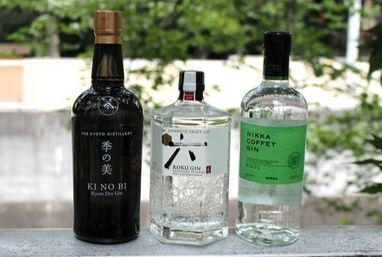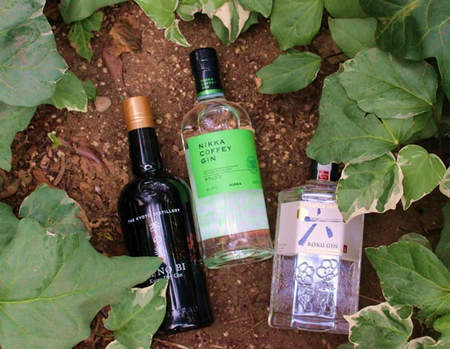What is Japan's history with gin?
Well, firstly it is important to understand that gin was never a spirit consumed in Japan. Go back 80 years and the big drinks consumed in Japan were port and whisky. As the years progressed, beer grew to be the most consumed alcoholic beverage in the country, followed by Nihonshu (sake). Up until 2016, when the Kyoto Distillery launched, there had never been a distillery purely dedicated to making gin in Japan. For decades, global brands like Gordon’s, Bombay Sapphire, and Tanqueray have been readily available in the country, and small distilleries have attempted to create some gin mock-ups, but only in recent years has gin really starting to attract a lot of attention, and take off domestically. What is the gin market like in Japan now? In recent years, wine, gin, and other foreign spirits have been growing steadily in popularity throughout the country, as more cocktail and wine bars open up and the Japanese population shows a rising interest in Western culture. There is also the aspect of health for the Japanese, as gin is seen globally as a low-calorie, “healthier” option when compared with other drinks. At the moment, the huge cocktail and mixology movement is continuing in Japan, especially in Tokyo. High quality is key, and many upmarket Western gins are entering the Japanese market dynamically, as consumption rises. This is also the reason why the huge producers in Japan, Suntory and Nikka, got involved in the craft gin movement. These companies are enormous, and don’t take steps that haven’t been well-researched and thought-out. Do the Japanese gin distilleries typically use traditional distillation methods? Well, right now one can count the companies producing gin in Japan with one hand. The Kyoto Distillery, however, which called itself Japan’s first craft gin distillery, uses an interesting distillation method. They break down the botanicals used into six categories, namely the Base, Citrus, Tea, Herbal, Spice and Floral. The botanicals in each category are distilled separately, and then blended back together. The Kyoto Distillery team claim this method makes for a much smoother, distinctive gin. Do the Japanese gins have a distinct style? The popular gins in Japan right now tend to use a selection of Japanese botanicals, as well as a handful that are used traditionally in gin production. Suntory’s ROKU (six) gin, is named so due to the six Japanese botanicals used in its distillation. These include cherry blossoms, cherry leaves, green tea, refined green tea, Japanese pepper and yuzu. Nikka Coffey Gin also includes several Japanese botanicals, and the Kyoto Distillery, which produces Ki No Bi gin, prides itself in using ingredients local to Kyoto, Japan. It’s easy to see that, for Japanese distilleries, Japanese ingredients don’t only give Japanese gins a very different, unique flavour compared with other gins; they are also used as a marketing tool to really separate them from other products and help them create a category of their own. Which gin servings are most popular in Japan? As the Japanese are very into living healthy, and take pride in the fact that their people live longer than any other race in the world, gin and tonics are a big hit, especially with young business women. The cocktail scene in Japan is huge, and makes use of some extremely high quality liquors and ingredients. As a result, one prime way gin is consumed is as the base of many tasty cocktails. Which Japanese gins should gin lovers try first? I would recommend people try Suntory ROKU gin and Nikka Coffey gin, as these are the big liquor producers in Japan, and have single-handedly made Japanese whisky a global phenomenon. So, you should expect no less from their gin products. What is your opinion of Japanese-inspired British gins? Kokoro Gin, and the more recent Japanese-inspired gin KURO, are interesting products and unique in their own way. While gin distillers based in Japan put the majority of their focus into creating Japanese ingredient based gins, these Japanese-inspired gins focus on creating a classic gin with a twist of Japanese flavour and culture thrown into the mix. Both gins are balanced, and very interesting, but at the same time, so different to gins made in Japan. Like whisky, the gin world is growing, and there are some amazing flavours and expressions out there. I guess we just need to try them all, and find what we enjoy the most! Which British gins are most popular in Japan? There are quite a few UK gins available in Japan. Hendrick’s, of course, is a top player in the country, and can be found in almost any high end cocktail bar in Tokyo, Osaka, and Kyoto. Sipsmith, which is one of my favourites, is also doing amazingly in Japan, which I know first-hand as I used to work for the company which imported it into Japan. Funnily enough, Suntory bought Sipsmith in 2016, which again proves that Japanese companies are really entering the gin movement dynamically. What's next for the Japanese gin industry and Japanese gins? If we take note of Japanese whisky and the universal boom that it’s experiencing presently, then the future looks bright for Japanese gins. I believe that, with the success of the first Japanese gin products, other small distilleries with follow suit and a huge gin distillery boom will occur in Japan. From then on, Japanese gin distilleries will continue to pursue perfection and quality, as the Japanese always do, and popularity for Japanese gin should sky-rocket in no time. I know I’ll be watching from the edge of my seat. Intrigued? Discover Japanese Gins for yourself at Dekanta. Comments are closed.
|


 RSS Feed
RSS Feed


